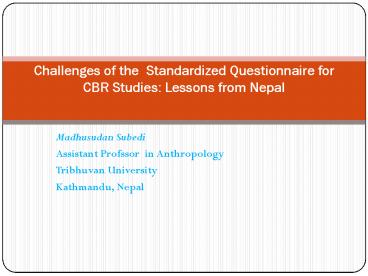Madhusudan Subedi - PowerPoint PPT Presentation
1 / 14
Title:
Madhusudan Subedi
Description:
The information collected from the disabled people or their caretakers included : ... For example, Brahmin generally do not have chickens and ducks in western Nepal ... – PowerPoint PPT presentation
Number of Views:32
Avg rating:3.0/5.0
Title: Madhusudan Subedi
1
Challenges of the Standardized Questionnaire for
CBR Studies Lessons from Nepal
- Madhusudan Subedi
- Assistant Profssor in Anthropology
- Tribhuvan University
- Kathmandu, Nepal
2
The Context
- Learning by involving the similar type of
research and consultancy (e.g. The Leprosy
Mission Nepal and The Netherlands Leprosy
Relief). - The information collected from the disabled
people or their caretakers included - Demographic characteristics,
- Socio-economic situation,
- Ability of self care,
- Limitation of daily activity, and
- Social participation.
3
Focus of the Discussion
- Issues of UNIVERSAL APPLICABILITY of the
survey Questionnaire versus LOCAL CONTEXT - Issues GENERALIZED SITUATION versus INDIVIDUAL
VARIATION within the District - Inadequate information about subjective feelings
in Survey Questionnaires
4
WHO ARE THE NEEDY PEOPLE FOR FINANCIAL /EQUIPMENT
SUPPORT?
- RELATIVELY POOR,
- MARGINALIGED,
- NOT ABLE TO AFFORD FOR SCHOOL OR REHABILATITIVE
SUPPORT
5
Disability Survey Situation in Nepal
- Government does not have minimum level of
information about the disable people and their
types at the various levels. - Many NGOs have been taking disability as a
crosscutting Issues, - Some NGOs claim that they have covered one third
of 75 district but in reality they have been
covering only few VDCs in the districts. - Dont have adequate data about the socio-economic
situation, types of disability, present
condition, need of supports and the expectation
of disabled people. - Some districts are overlapped and some districts
are completely underserved.
6
One of the major issues, that I found, which
should be properly explored is economic one.
The economic indicators greatly vary based on
the place of residence of the respondents (e.g.
urban versus rural), valuable economic assets in
the program areas (large animals, productive
lands, fallow lands buildings of various types ,
occupation, family income and personal income,
shares, pensions, rents and so on).
7
Where Did We Face Difficulty?To explore the
economic situation of the person
- How many larger animals does the family own
(goats, cows, buffalo, pigs etc.)? RDA Tool for
Household Survey - This question will be more applicable in rural
areas and less applicable in urban areas. Animal
husbandry is not so common in urban areas . - How many small animal does the family own
(chickens, ducks etc.)? RDA Tool for Household
Survey - This issue also depends on the place of residence
(Rural or Urban) and cultural of the caste/ethnic
group in Nepal. For example, Brahmin generally do
not have chickens and ducks in western Nepal
due to the concept of purity and pollution. - How much is your monthly family income? RDA Tool
for Household Survey . It is very difficult to
estimate the family income because most of the
rural people have subsistence farming, family as
unit of production and consumption.
8
Where Did We Face Difficulty? (Conti..)
- How much land do your family own? Or, How much
land do you own? This question seems very simple
but it should also be remembered that the types
of land, productivity, cropping intensity and the
price greatly vary even within the village. - The expected support from the external
organizations (INGOs, GO) also varied based on
the educational status and the opportunities of
having exposure to other areas rather than the
real need of the disabled person.
9
We should be serious to collect the real
situation of the disabled person because.
- We have to find out the real need of the disabled
person - We have limited resources
- We have to prioritized the cases
- We should give them justice
- Link Disabled persons and facilities to the
facilities and services
10
What can be done for the SURVEY QUESTIONNAIRE ??
- Based on the local context, PROXY economic
indicator can be made - 1. Food Sufficiency Months from own production
in the rural areas. (For example, Less than 3
months, Up to 6 months, Up to 9 months, 12
months, and Surplus. - Main Source of Income of the Family
- Other sources of income of the family
- ONE OF THE KEY ISSUE SHOULD BE OBSERVATION
11
What Additional Do We Need ?
- The narratives and case stories of the disabled
person. Appreciation of narratives and case
stories are equally important, as a way of
acknowledging the individual experiences and
difficulties. - Without the context provided by fieldwork, people
with disabilities are at risk of becoming their
impairment in a new discourse of help and
rehabilitation. They lose the cultural dimension
of personhood. - Thus, a more in-depth need assessment to the
disabled person (i.e. the potential candidate to
receive service) should be done before
implementing the rehabilitation program.
12
What Additional Do We Need (Conti.)
- I had an opportunity to discuss about the RDA
Tool with Wim H. van Brakel in Kathmandu. I feel
that some pertinent questions should be added in
RDA Tool for finding the real needs of the
disabled person. For example, what makes it
harder (or easier ) for them to participate in
the community. - Field Researcher found some difficulty to
collect information about WHODAS 12-item Core
Questions. It was observed that only adequately
trained perosn of having highere level knowledge
on disablity can rephrase the question properly
(if the respondent does not properly understand)
and get valid information.
13
WHAT CAN BE DONE TOGETHER?
- Common Understanding of Minimum level of
information required for CBR for DISABLED people.
- Sharing the SURVEY DATA and REPORT with other
supporting/facilitating Organization including
the GoN - Avoid the duplication of the programs
- Link between person with disabilities and those
who provide the working environment/services to
them
14
THANK YOU































